Our verdict
- Top pick in best PUMA running shoes
Pros
- Endless cushioning
- Stretchy, comfortable tongue
- Outstanding traction
- Rock-solid stability
- Ideal for long-distance training
- Great for heel strikers
- Good value for being a supertrainer
- Good value for being a supertrainer
Cons
- Heavier than most competitors
- Outsole shows fast wear
- Lacks agility
- Not enough energy return from Nitro
Audience verdict
- Top 11% in road running shoes
- Top 15% in PUMA running shoes
Comparison
The most similar running shoes compared
+ + Add a shoe | |||||
|---|---|---|---|---|---|
| Audience score | 91 Superb! | 89 Great! | 90 Superb! | 90 Superb! | |
| Price | £170 | £160 | £210 | £170 | |
| Pace | Daily running | Daily running | Daily runningTempo | Daily running | |
| Shock absorption | High | High | Moderate | High | |
| Energy return | Moderate | Moderate | High | Moderate | |
| Traction | High | High | High | High | |
| Arch support | Neutral | Neutral | Neutral | Neutral | |
| Weight lab Weight brand | 10.3 oz / 291g 10.3 oz / 292g | 9.9 oz / 282g 10 oz / 283g | 8.9 oz / 252g 8.8 oz / 250g | 9.6 oz / 272g 9.7 oz / 275g | |
| Drop lab Drop brand | 9.6 mm 8.0 mm | 8.7 mm 5.0 mm | 8.2 mm 8.0 mm | 9.4 mm 6.0 mm | |
| Strike pattern | HeelMid/forefoot | HeelMid/forefoot | HeelMid/forefoot | HeelMid/forefoot | |
| Size | True to size | True to size | True to size | True to size | |
| Midsole softness | Soft | Soft | Soft | Balanced | |
| Difference in midsole softness in cold | Big | Normal | Small | Small | |
| Toebox durability | Decent | Decent | Good | Decent | |
| Heel padding durability | Decent | Good | Good | Bad | |
| Outsole durability | Decent | Good | Good | Good | |
| Breathability | Moderate | Breathable | Breathable | Moderate | |
| Width / fit | Medium | Medium | Medium | Medium | |
| Toebox width | Medium | Narrow | Medium | Medium | |
| Stiffness | Stiff | Stiff | Stiff | Stiff | |
| Torsional rigidity | Stiff | Stiff | Stiff | Stiff | |
| Heel counter stiffness | Moderate | Stiff | Moderate | Moderate | |
| Rocker | ✓ | ✗ | ✓ | ✓ | |
| Heel lab Heel brand | 42.9 mm 47.0 mm | 39.3 mm 39.0 mm | 42.8 mm 45.0 mm | 39.9 mm 37.0 mm | |
| Forefoot lab Forefoot brand | 33.3 mm 39.0 mm | 30.6 mm 34.0 mm | 34.6 mm 37.0 mm | 30.5 mm 31.0 mm | |
| Widths available | Normal | NormalWide | NormalWide | Normal | |
| Orthotic friendly | ✓ | ✓ | ✓ | ✓ | |
| Season | All seasons | SummerAll seasons | SummerAll seasons | All seasons | |
| Removable insole | ✓ | ✓ | ✓ | ✓ | |
| Ranking | #32 Top 9% | #114 Top 31% | #77 Top 21% | #40 Top 11% | |
| Popularity | #136 Top 37% | #117 Top 32% | #22 Top 6% | #203 Bottom 45% |
Who should buy
We were eager to test Puma's largest shoe yet, and we found it perfect for:
- Runners seeking tonnes of cushioning—the MagMax Nitro’s maximalist build offers plenty of it.
- Those looking for a supertrainer that prioritises stability and support over speed and agility.
- Long-distance runners who dislike ground feel and need an ultra-cushioned shoe for long runs and recovery sessions.
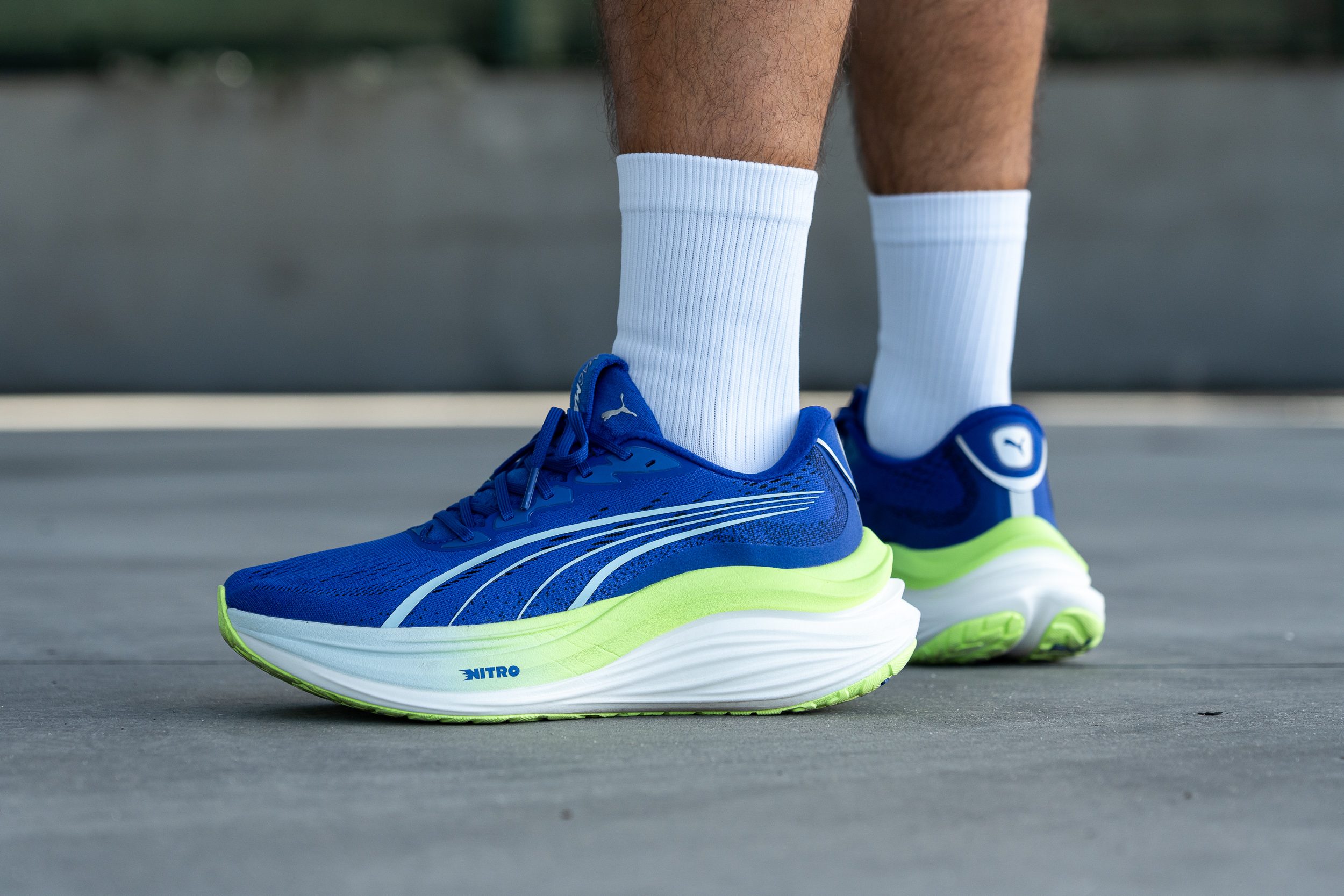
Who should NOT buy
We found that while the MagMax Nitro weight isn’t exactly a disaster, it’s noticeably heavier than many other supertrainers, especially when stacked up against the Mizuno Neo Vista. And if you prefer to skip the Japanese brand, we think the Hoka Skyflow is a good choice too.
We also think that runners aiming for faster paces in a supertrainer will likely find the MagMax Nitro ankward. For speedier efforts, we recommend the ASICS Superblast 2 (no plate) or the ASICS Magic Speed 4 (carbon plate), which effortlessly handle a variety of faster paces.
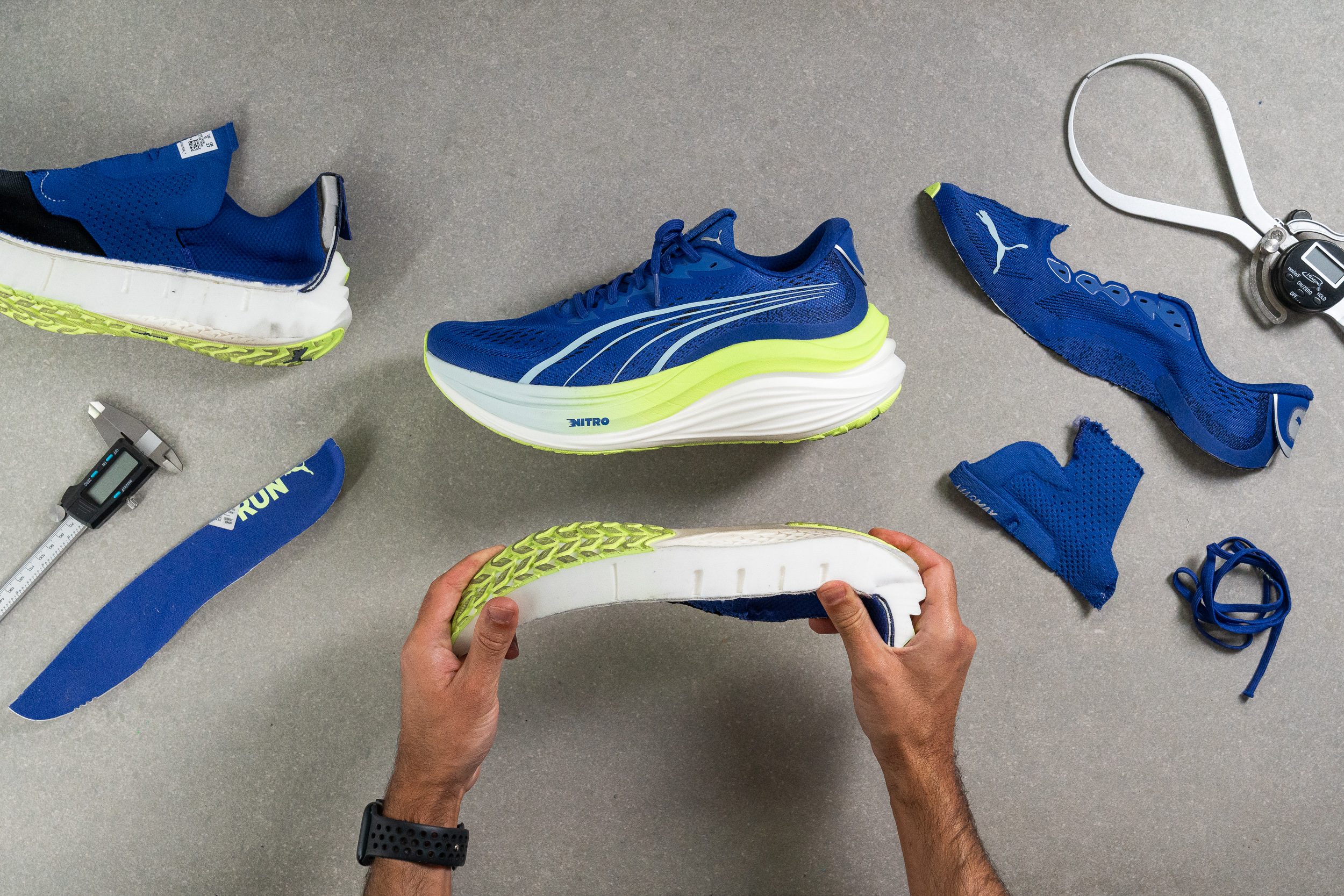
Cushioning
Shock absorption
The MagMax Nitro is a heavy-duty shock absorber built to cushion every step. Few shoes come close to its 148 SA in the heel... and even fewer to the colossal 139 SA in the forefoot.
In other words, if your priority is shielding your legs from pounding impact, this might be the ultimate protection-focused trainer.

| Puma MagMax Nitro | 148 SA |
| Average | 129 SA |
Energy return
While shock absorption shines in both the heel and forefoot, we can't ignore how lacklustre the energy return was. Despite its nitrogen-infused Nitro foam, we only measured 55.5% in the heel and 57.3% in the forefoot, underwhelming no matter the angle.
So, is this a deal breaker for you? Only if you're planning to use the MagMax Nitro for pace-pushing long runs. As a comfort-focused, slow-paced trainer, the low bounce won’t be a major concern.
| Puma MagMax Nitro | 55.5% |
| Average | 58.5% |
Heel stack
This shoe's weight has a solid reason behind it—its jumbo-sized stack height, which elevates the rearfoot to 42.9 mm from the ground, firmly placing it in the maximalist running shoe category.
Though it falls slightly short of Puma's stated 47 mm, we found that 42.9 mm is enough. In our experience, adding more height could have even been detrimental, given the shoe's weight-to-stack ratio.
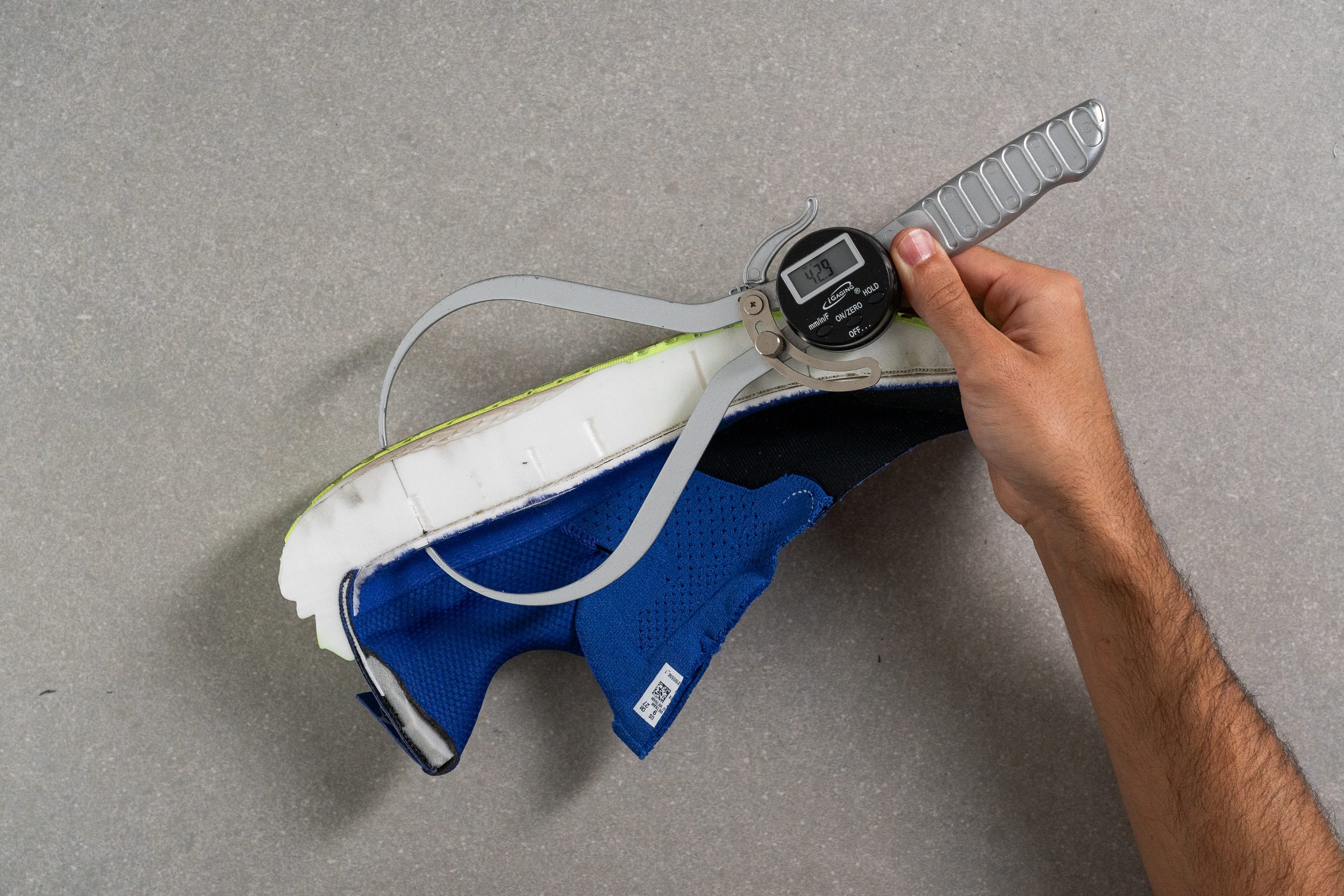
| Puma MagMax Nitro | 42.9 mm |
| Average | 34.8 mm |
Forefoot stack
The forefoot also measured shorter than anticipated at 33.3 mm, yet it's still much higher than most running shoes and clearly suitable for forefoot and midfoot strikers. It's ideal for those seeking zero ground feel and maximum protection underfoot.
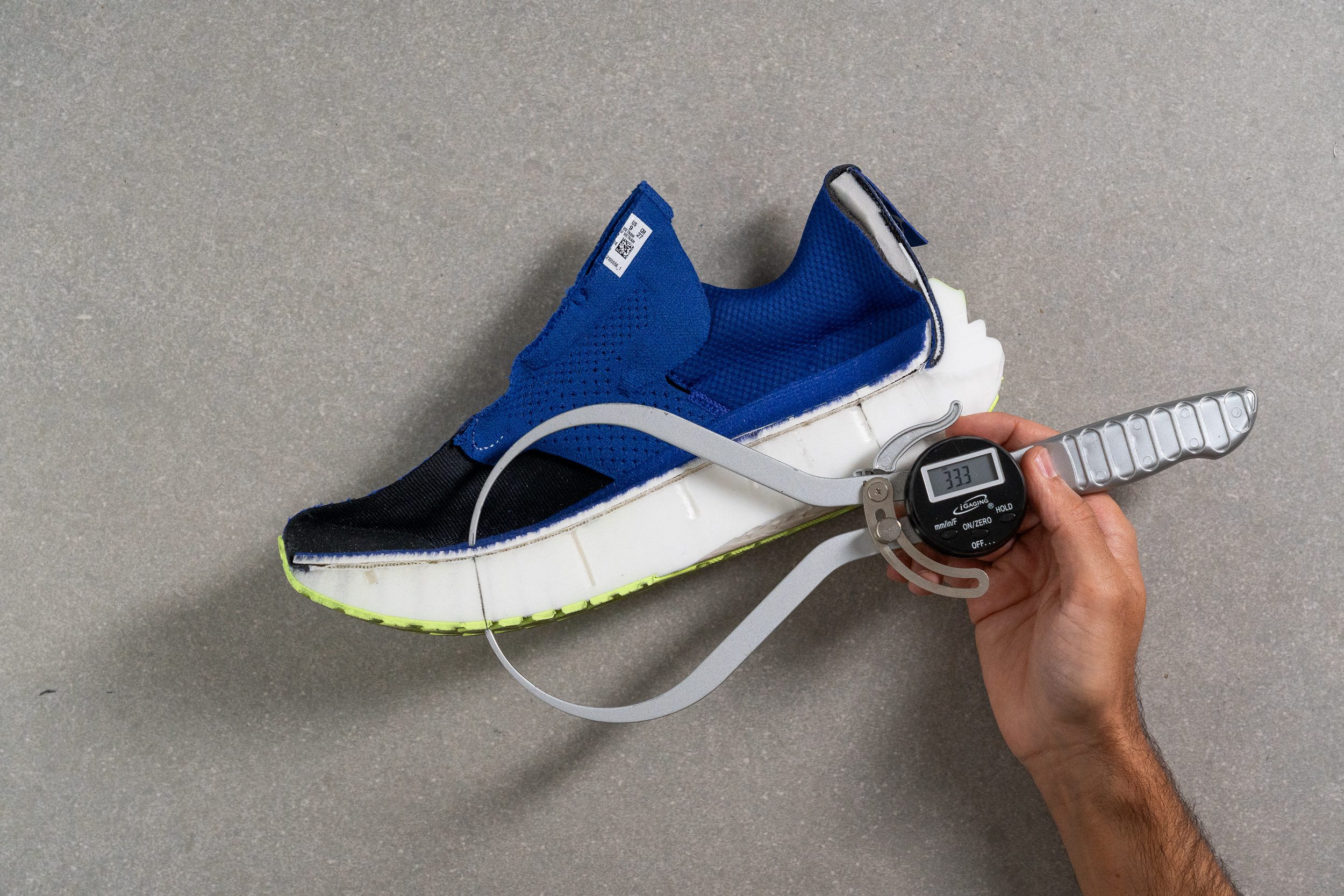
| Puma MagMax Nitro | 33.3 mm |
| Average | 26.2 mm |
Drop
If you're good with numbers, you may have already calculated it, but if not, the MagMax Nitro has an actual heel-to-toe drop of 9.6 mm. This makes it even more appealing to heel strikers than the Puma-stated 8-mm offset, though the 1.6-mm difference is minor.

| Puma MagMax Nitro | 9.6 mm |
| Average | 8.6 mm |
Midsole softness
Some supertrainers combine two different foams, but Puma surprised us by sticking solely to Nitro foam and leaving Nitro Elite out, a different approach from the Deviate Nitro 3. While it would've been great to have their top-tier compound here, we understand it helped keep the price lower than some competitors.
Nitro is a nitrogen-infused foam that delivers both lightness and solid energy return, offering a far better ride than almost any other mid-tier foam on the market. Using a single slab instead of a dual setup also benefits durability, as it eliminates the risk of layers separating over time.
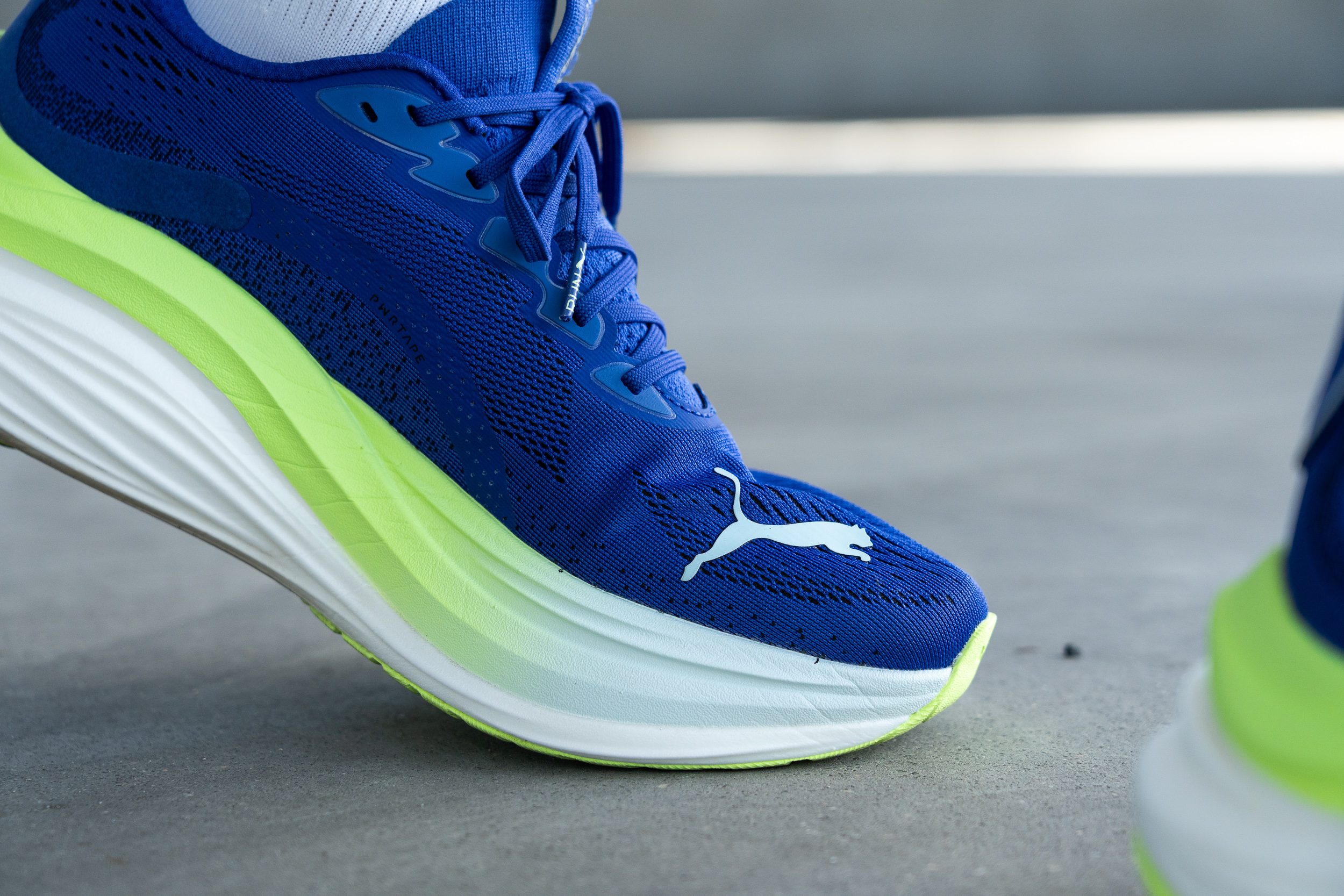
In our view, with the massive stack height of this shoe, Puma couldn't afford to make the foam too soft. We measured 18.3 HA on our durometer—an ideal balance that suits the MagMax very well.
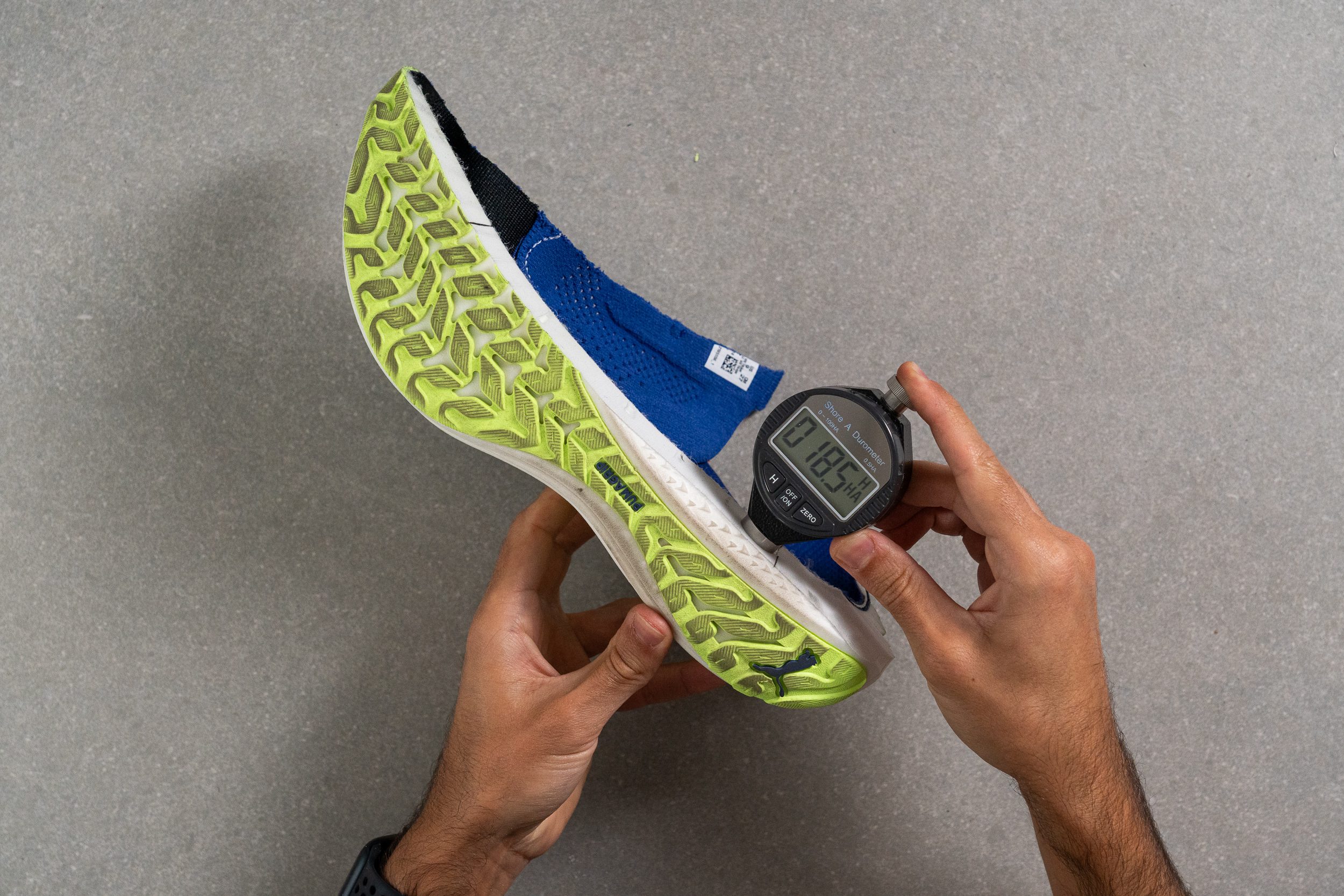
| Puma MagMax Nitro | 18.3 HA |
| Average | 20.4 HA |
Rocker
The MagMax Nitro features a prominent rocker that begins 10 cm before the toe, essential for aiding turnover due to the shoe’s substantial stack height. The heel also boasts a significant curvature, crucial for heel strikers—especially those who land heavily on their rearfoot. Without it, they'd struggle to move forward smoothly.
Overall, we found the rocker to be smooth and natural, making the ride feel fluid and effortless in such a maximalist running shoe.
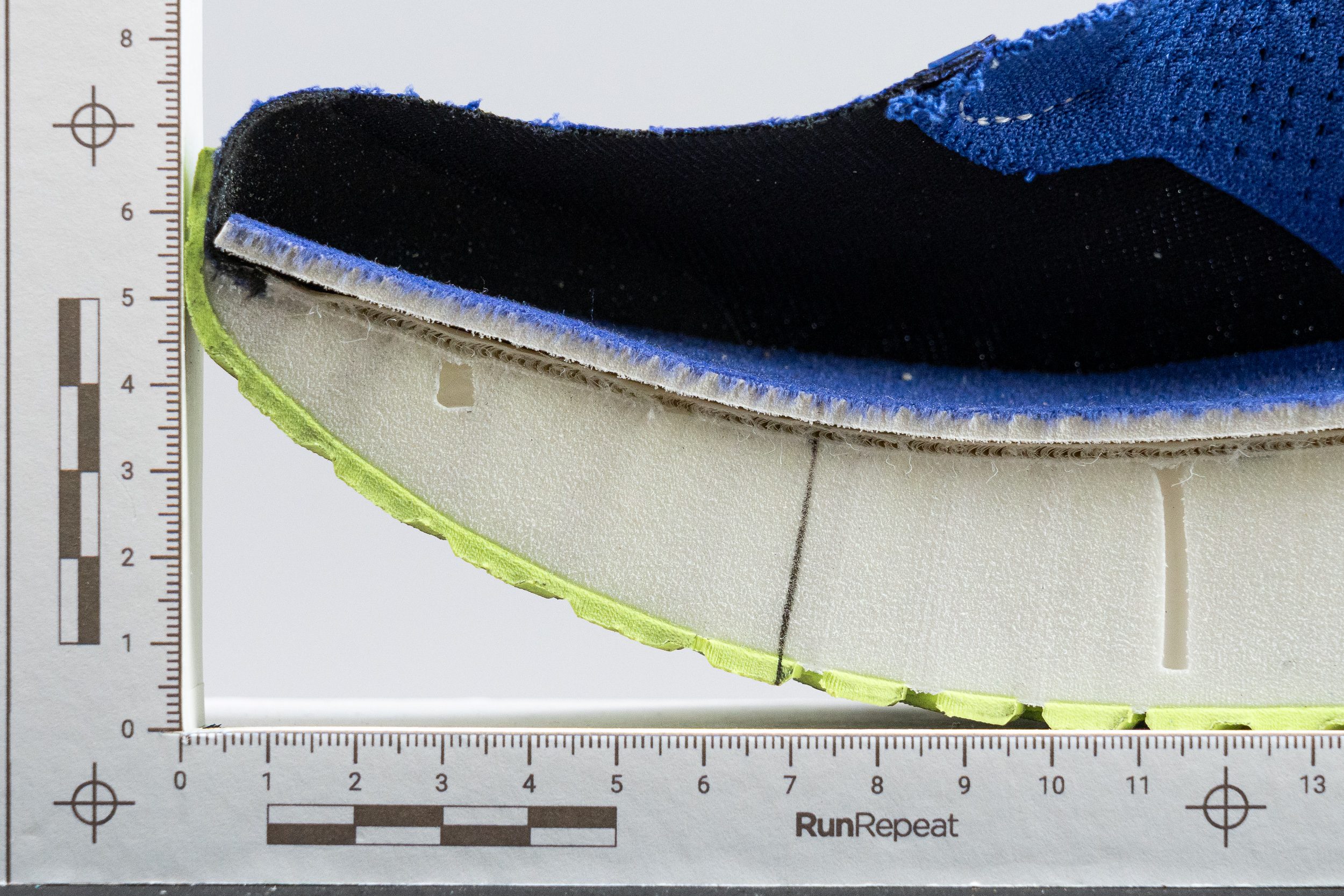
Size and fit
Size
Puma MagMax Nitro fits true to size (72 votes).
Width / Fit
In the MagMax Nitro, we discovered slightly more room than usual for this brand, measuring 97.1 mm at the widest point. We think that's a positive improvement for workouts lasting over one hour.
It's clear to us that this subtle yet significant change was made because, unlike other Puma trainers, the MagMax Nitro is 100% built for long distances, where having enough interior space is crucial.
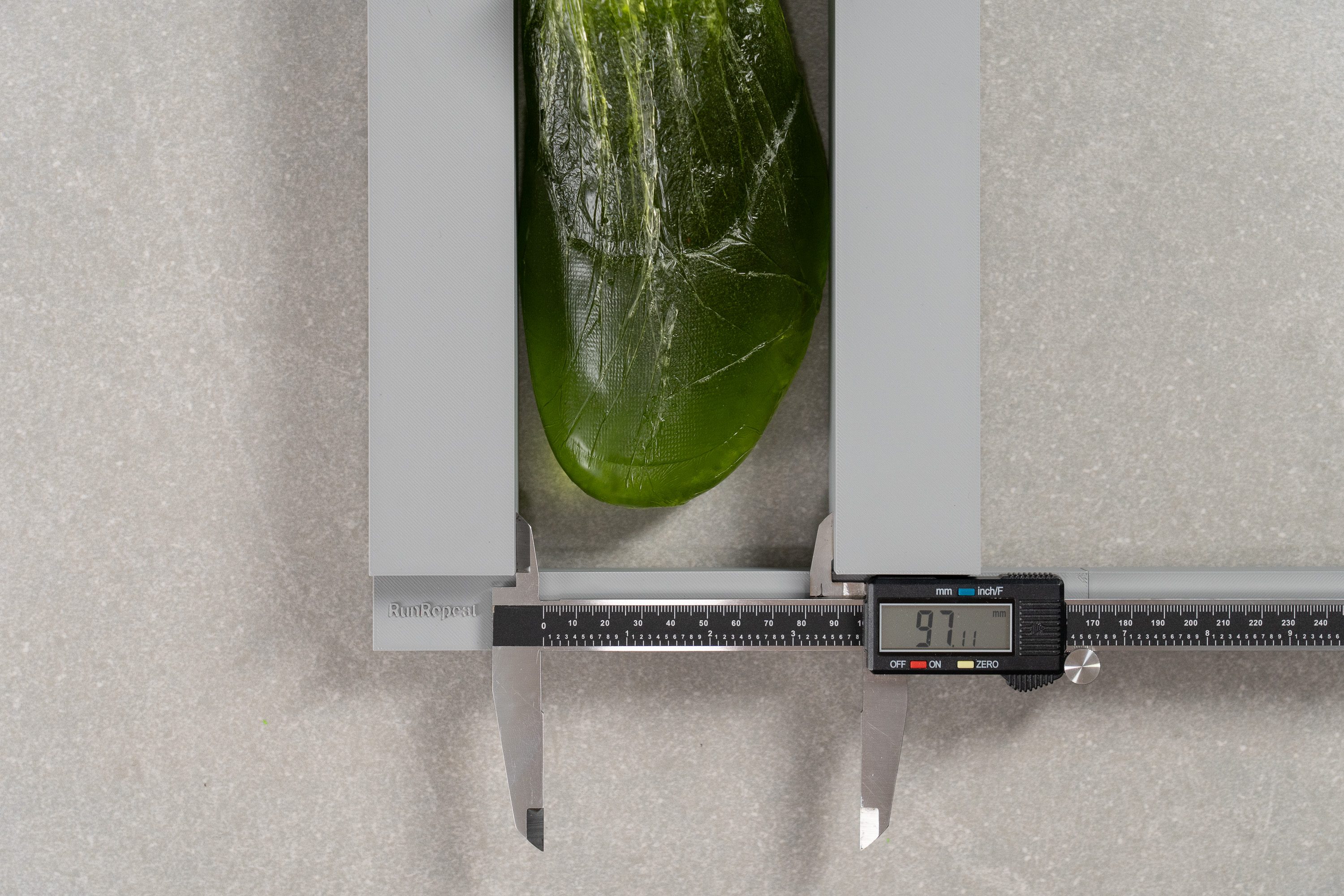
| Puma MagMax Nitro | 97.1 mm |
| Average | 95.1 mm |
Toebox width
The toebox tapers like most Puma shoes, so don’t expect abundant space in this area.
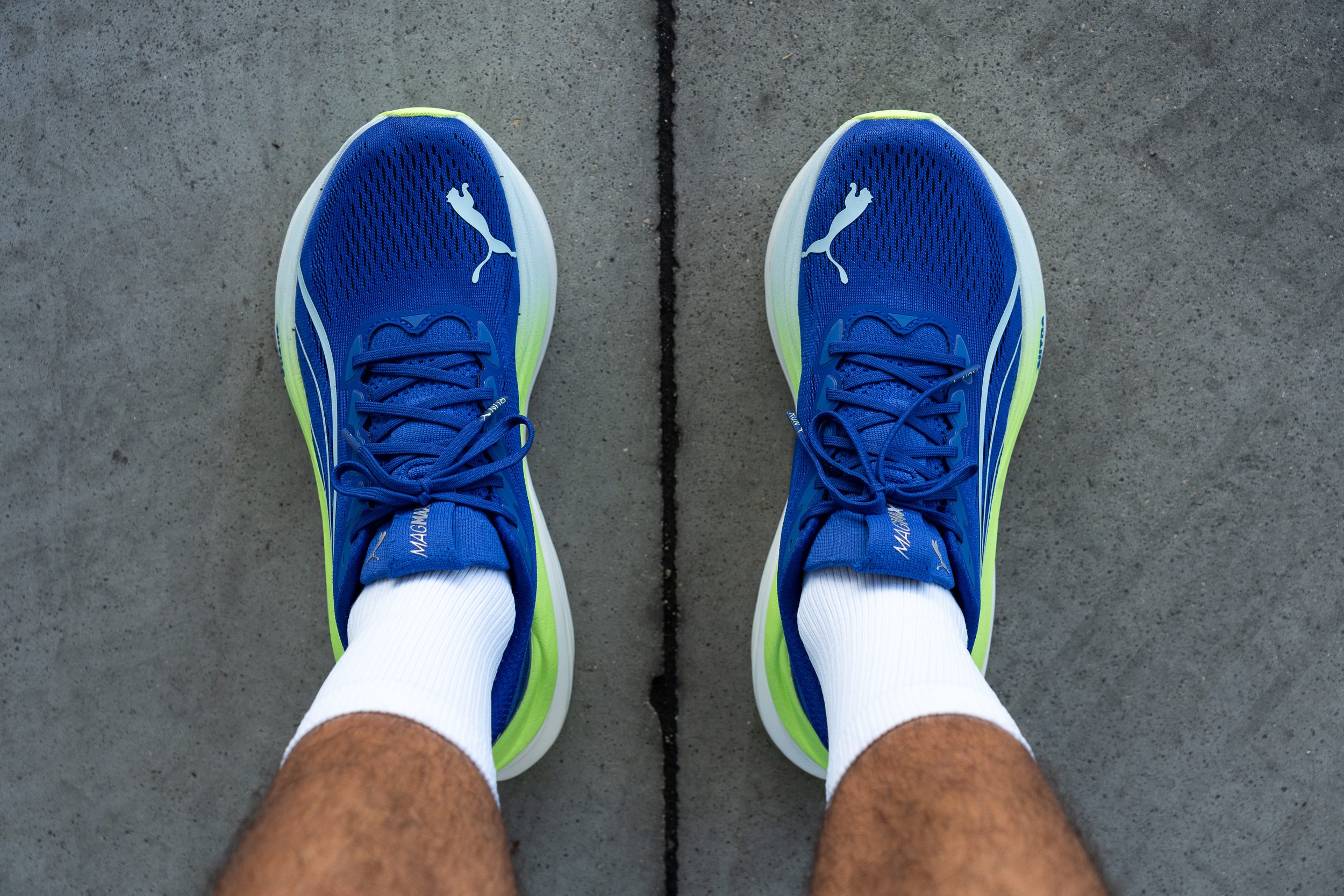
However, we found that 72.3 mm is a decent measurement, especially when paired with the ultra-stretchy and flexible upper material.
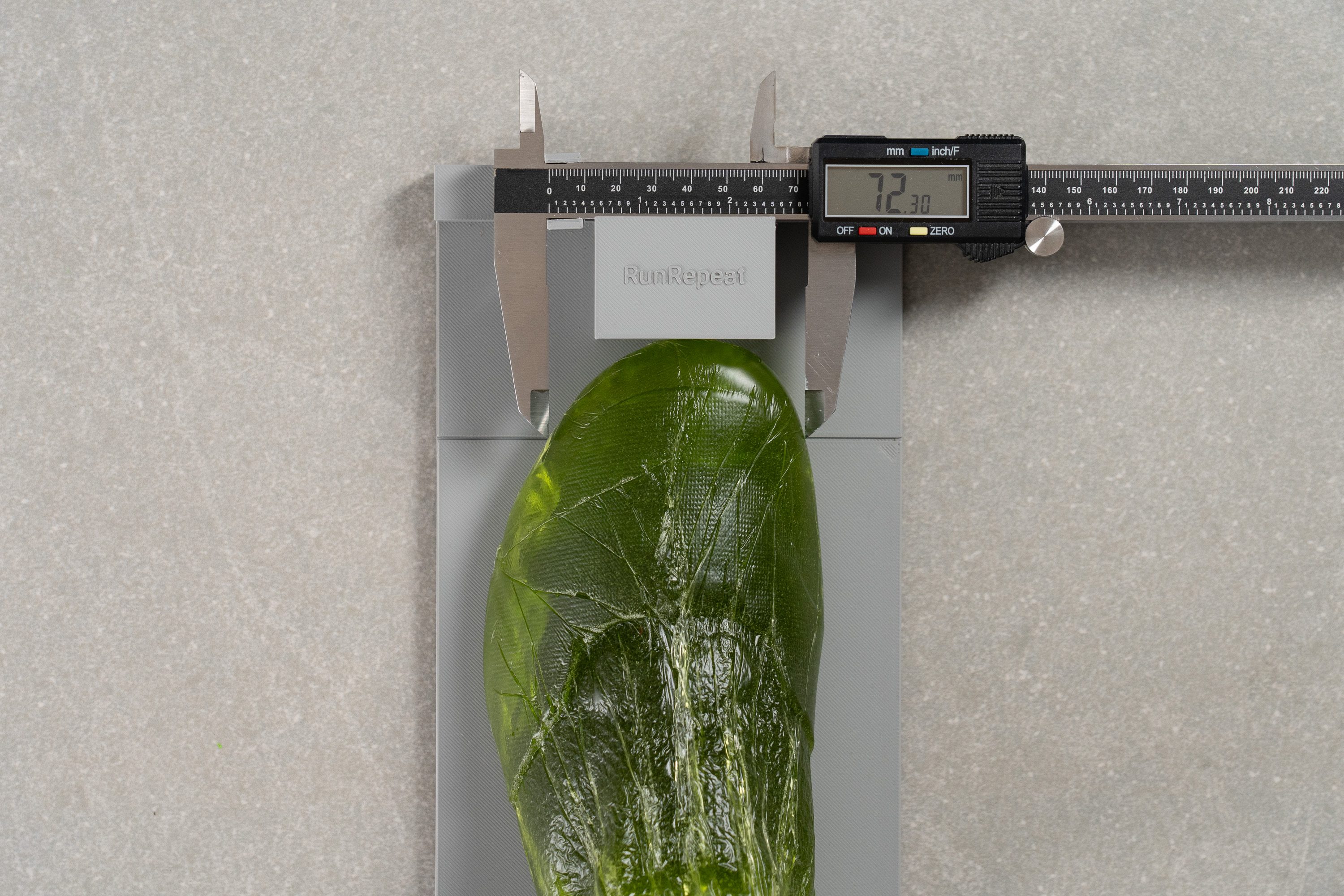
| Puma MagMax Nitro | 72.3 mm |
| Average | 73.2 mm |
Toebox height
We found that the height in the toe area provides decent volume for upward movement thanks to the non-restrictive upper material, but it’s far from impressive. Measuring 26.4 mm, it’s below average compared to most running shoes.
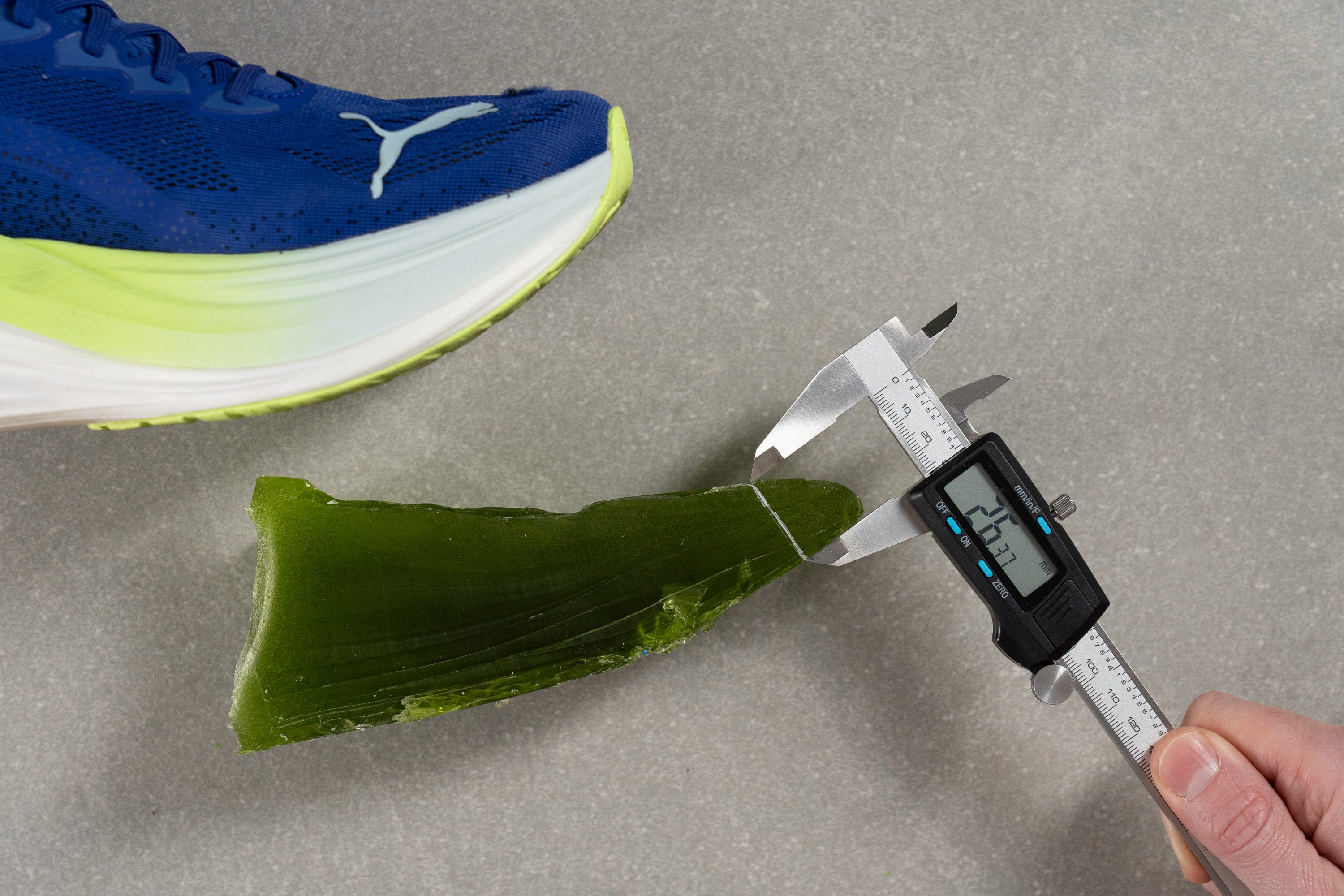
| Puma MagMax Nitro | 26.4 mm |
| Average | 27.1 mm |
Traction / Grip
Traction test
In the lab, we always raise the bar for shoes featuring top-tier rubber—especially when the Dassler rivalry flares up between PUMA (PumaGrip) and Adidas (Continental). Yes, even decades later, the battle continues underfoot!
We tested the MagMax in wet conditions and recorded a solid 0.60 score. That puts it squarely in the great grip category, delivering confident traction on soaked concrete, dry pavement, and everything in between.
| Puma MagMax Nitro | 0.60 |
| Average | 0.48 |
Outsole design
We can confirm that the MagMax Nitro uses the same ultra-grippy rubber as Puma's top supershoe, the Deviate Nitro Elite 3. However, the MagMax features more extensive outsole coverage as it's not a racing shoe.
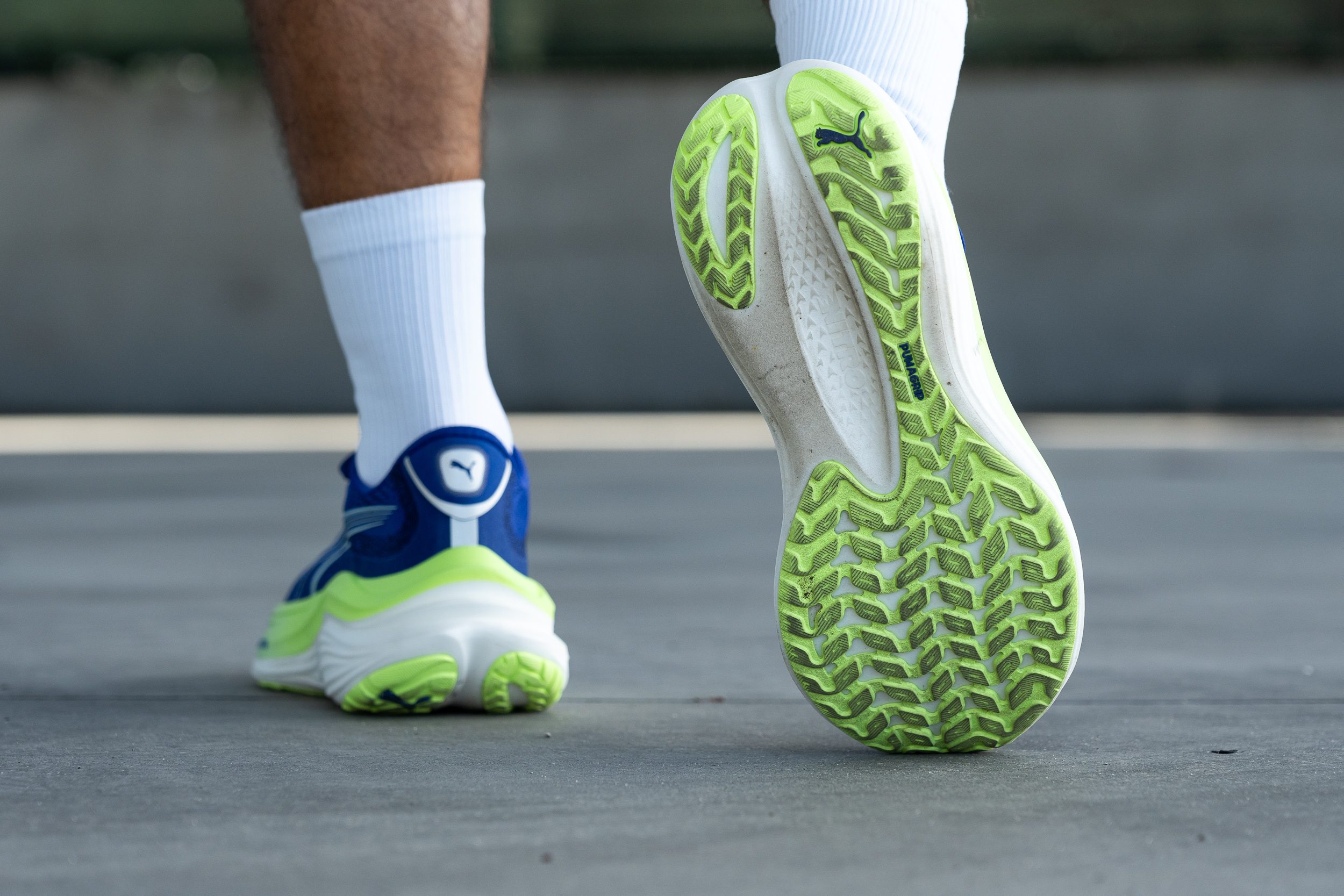
Flexibility / Stiffness
With its sky-high torsional rigidity and massive midsole, we were initially sceptical about the longitudinal stiffness of the MagMax Nitro.
We tested it using our 30-degree bend method and found results similar to nylon-plated tempo shoes. While this isn't a bad outcome at all, we believe it's not ideal for those seeking a shoe for walking or all-day wear—it feels a bit too stiff if comfort is your main priority.
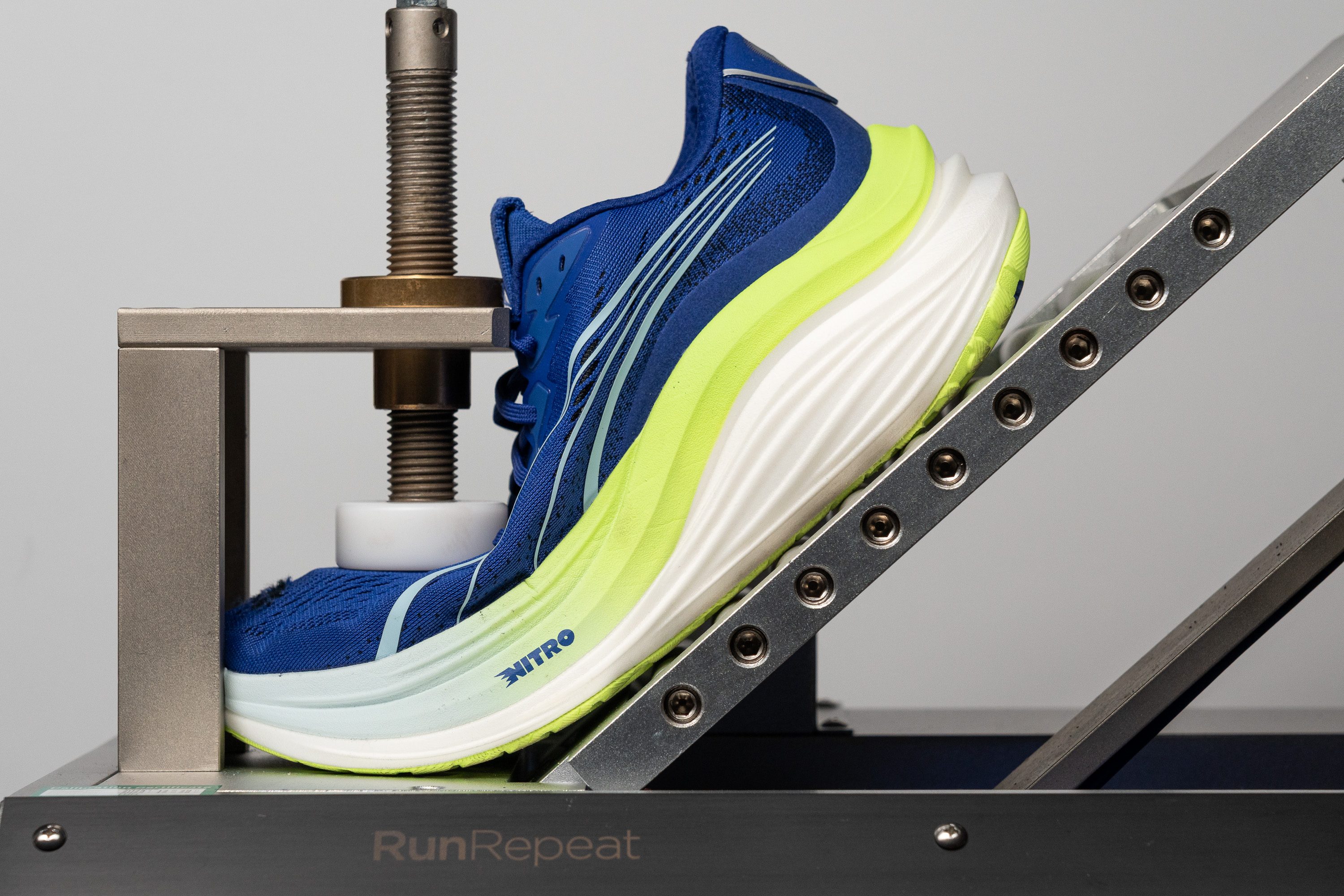
| Puma MagMax Nitro | 17.9N |
| Average | 15.3N |
Stiffness in cold (%)
We obtained the exact same result after freezing the shoe for another 20 minutes, which is quite unusual in our lab tests!
| Puma MagMax Nitro | 0% |
| Average | 33% |
Weight
Discussing the weight of this shoe is a bit of a mixed bag. On one hand, we believe it's even lightweight for its massive, behemoth-like build at just 10.3 oz or 291g. But on the other hand, it's still heavy when compared to a standard road daily trainer or average running shoe.
In our view, if weight isn't a significant factor for you, then the MagMax Nitro should suit you well. However, if you prefer a shoe that feels almost weightless on your feet, this is not going to work for you.
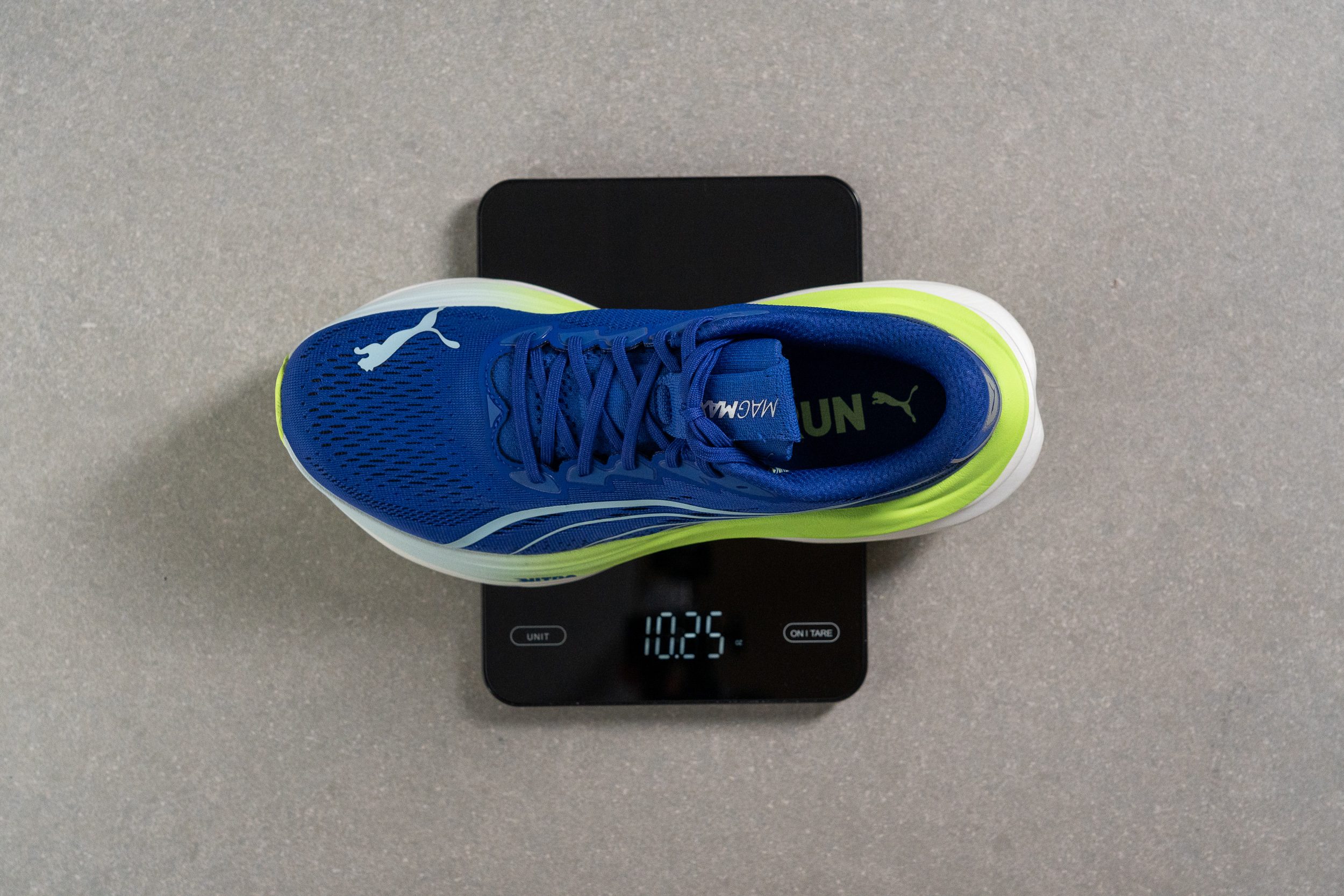
| Puma MagMax Nitro | 10.3 oz (291g) |
| Average | 9.3 oz (264g) |
Breathability
From the moment we unboxed the blue MagMax Nitro that we purchased, we noticed the upper was exceptionally plush and comfortable—though this raised some concerns about breathability. Naturally, we wanted to find out if it could deliver enough airflow.
We began with our signature smoke test, connecting our machine to a custom-designed, 3D-printed piece to direct smoke into the toebox. We found it performed well, earning a solid 4/5 on our scale.
Next, we used a light to examine the placement of ventilation holes in the toebox and medial area. We saw that Puma aimed for a balance of airflow and support, with less ventilation from midfoot to heel—a choice that made sense to us given the towering stack height of this shoe.
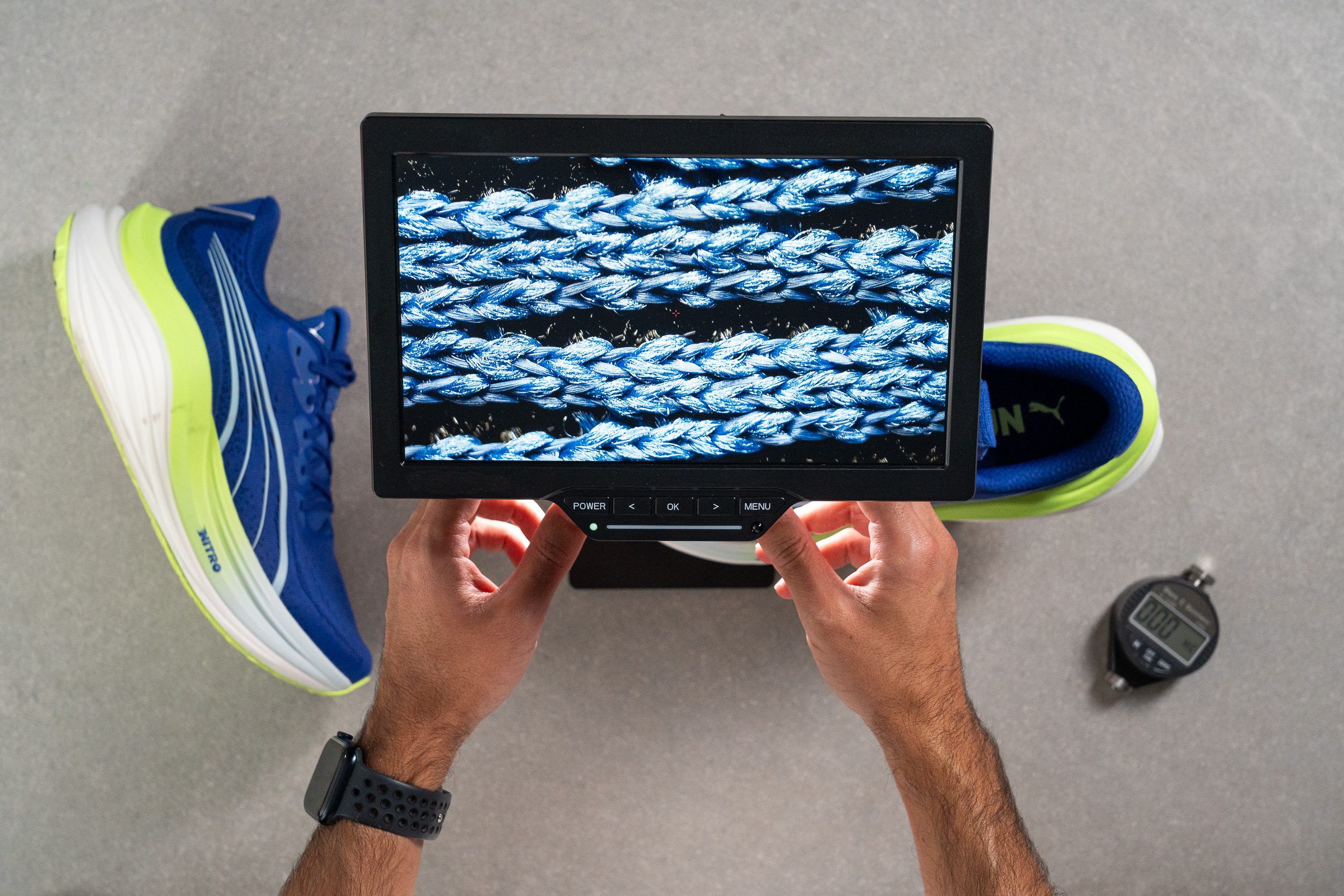
Under the microscope, we found an engineered mesh upper that was surprisingly standard. While Puma often experiments with unique materials and designs, this one resembled the uppers found in many other daily trainers.
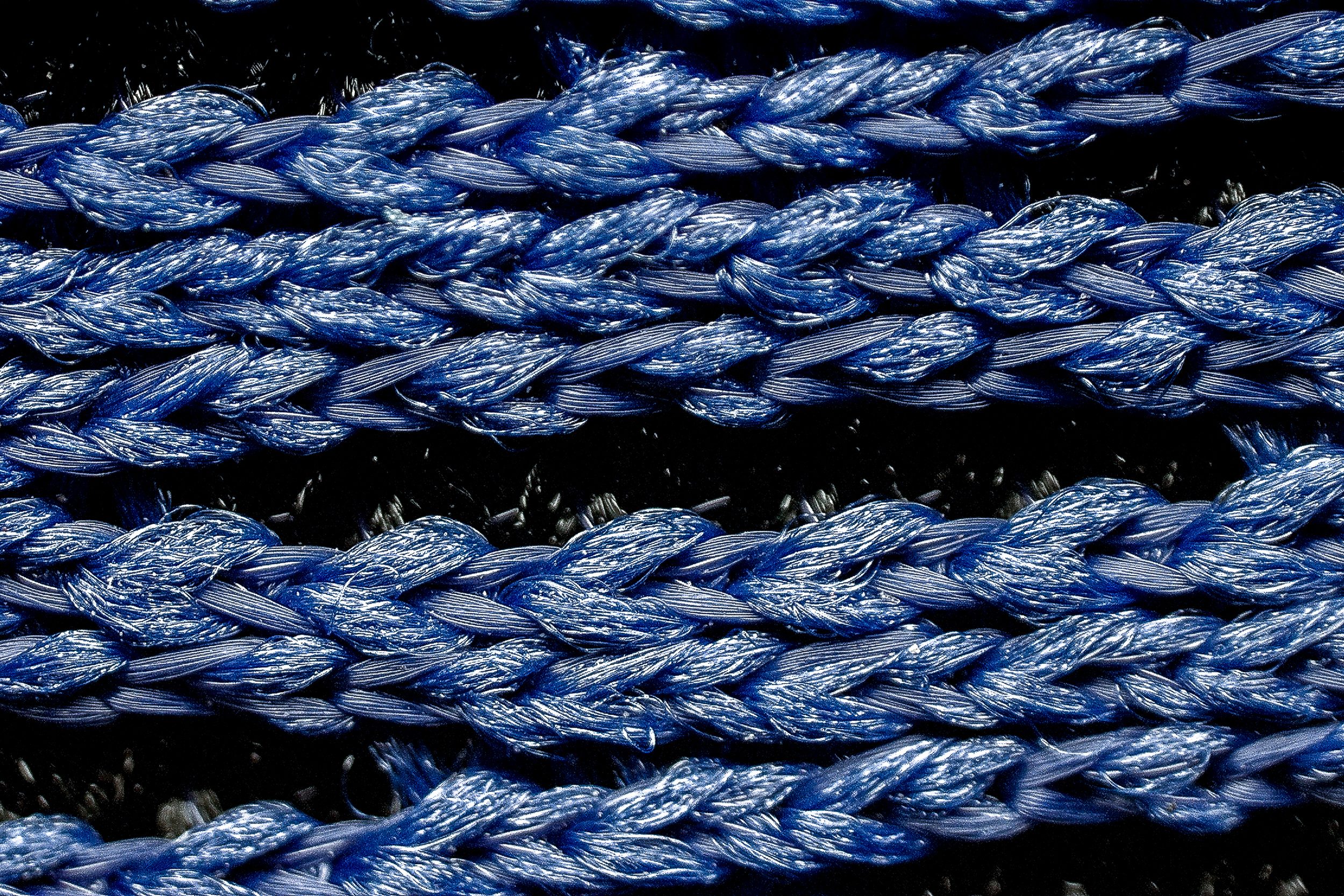
Puma often uses thermoplastic overlays (PWRTAPE) to enhance the structure of the upper. We wanted to check if these overlays would restrict airflow, but we found that they don’t.

Overall, we think this upper suits this shoe very well, with ample padding and adequate ventilation. For us, it passes the test!
| Puma MagMax Nitro | 4 |
| Average | 3.7 |
Stability
Lateral stability test
The Puma MagMax Nitro is built for neutral runners, but to handle its towering stack height, Puma added several guidance features, including midsole sidewalls, a massive sole flare extending along the midsole's sides, and a highly rigid construction.
For these reasons, we believe that runners with moderate stability needs can use this shoe, though we still think its primary focus should be on neutral runners, regardless of their footstrike.
Torsional rigidity
Crafting a shoe that's flexible from a torsional standpoint becomes challenging when the heel exceeds 40 mm and the forefoot goes over 30 mm.
In our experience, having 5/5 torsional rigidity helps provide a slight stability boost by keeping the forces centred in the MagMax Nitro. Of course, such high rigidity can make the shoe feel a bit less comfortable, but we believe it is necessary to maintain control given the high stack height.
| Puma MagMax Nitro | 5 |
| Average | 3.5 |
Heel counter stiffness
In our testing, we found that the heel counter strikes a solid balance, scoring 3/5 in stiffness.
It’s firm enough to provide support without feeling overly rigid. For us, this design seems aimed at satisfying a wide range of runners, and it succeded.
| Puma MagMax Nitro | 3 |
| Average | 2.9 |
Midsole width - forefoot
From the moment we started working with this shoe in the lab, it looked enormous, but it wasn’t until we measured it that we realised its true massive scale. When we took our digital callipers to measure the forefoot width—coming in at a whopping 126.9 mm—we were genuinely amazed.
This is one of the widest shoes we've ever tested in the lab, and we found that its broad base is a key reason behind the stable feel, even with its towering height. Think of it as driving a massive SUV—it's not built for quick turns or rapid accelerations, but you'll be super comfortable cruising the highway.
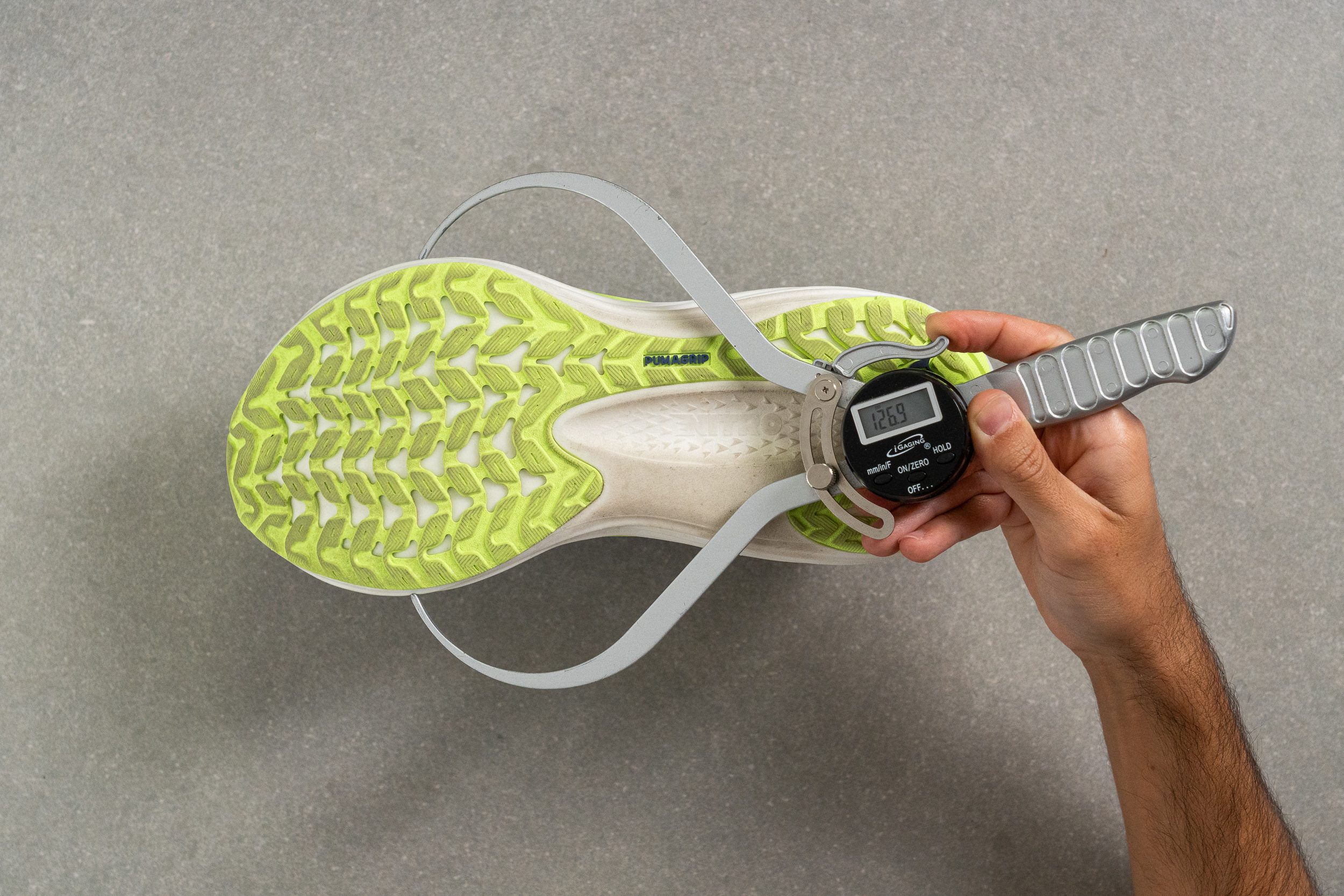
| Puma MagMax Nitro | 126.9 mm |
| Average | 114.4 mm |
Midsole width - heel
The heel follows the same design concept as the forefoot—remarkably wide compared to 9 out of 10 running shoes on the market today. We measured it at 105.8 mm, which should be more than enough for heel strikers who require extra stability compared to the typical neutral workhorse.
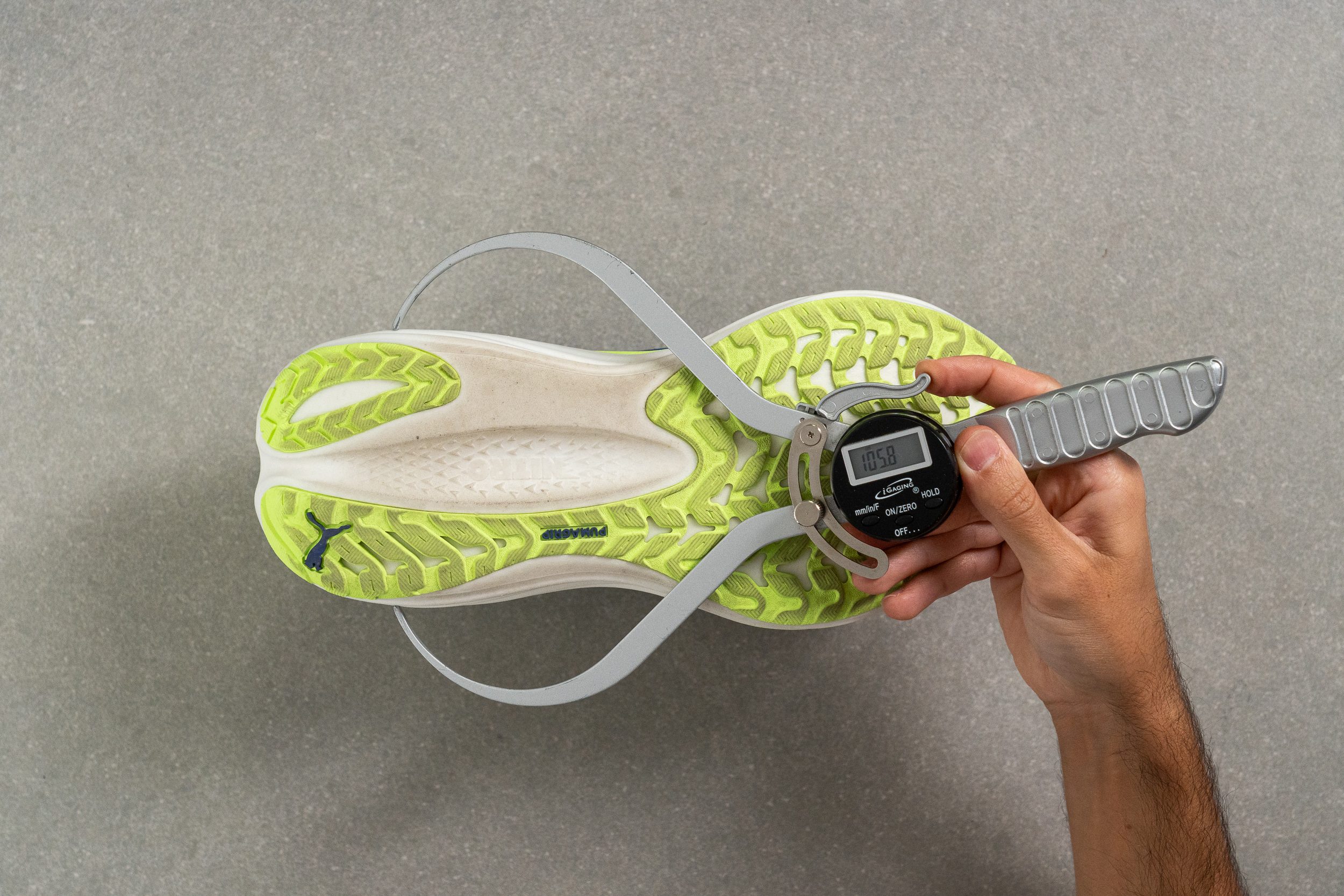
| Puma MagMax Nitro | 105.8 mm |
| Average | 90.7 mm |
Durability
Toebox durability
The advantage of using a classic engineered mesh upper is that durability tends to be reliable, even with numerous ventilation holes—especially compared to knit materials.
We gave it a 3/5 in the Dremel test. While not an outstanding result, it’s sufficient to handle the typical wear and tear of road running.

| Puma MagMax Nitro | 3 |
| Average | 2.6 |
Heel padding durability
Although the MagMax Nitro here earned the same 3/5 result as our previous test in the toebox, we found it slightly underwhelming compared to its competitors in the heel. Nonetheless, this score it’s far from disappointing.
The issue lies in the lining, which isn't plain but includes tiny ventilation holes. While these improve breathability, they also create weak points that are more prone to damage.

| Puma MagMax Nitro | 3 |
| Average | 3.4 |
Outsole hardness
We found the outsole’s surprisingly soft rubber—measuring 74.0 HC—delivered exceptional traction, which we expected from the well-known PumaGrip.

Our tests confirmed that the MagMax Nitro uses the same ultra-grippy rubber as Puma's top supershoe, the Deviate Nitro Elite 3. However, the MagMax features more extensive outsole coverage, and we anticipate a thicker measurement when we gauge it shortly.

| Puma MagMax Nitro | 74.0 HC |
| Average | 79.2 HC |
Outsole durability
Durability-wise, the result isn't great—something we anticipated given the soft PumaGrip formulation and the fantastic traction we experienced even on dirt roads.
We measured the dent with a tyre tread gauge and found 1.4 mm of rubber wear. This is more than we’d prefer and could lead to early wear for heavier runners prone to this issue, but we also believe it’s only slightly concerning for the average runner.
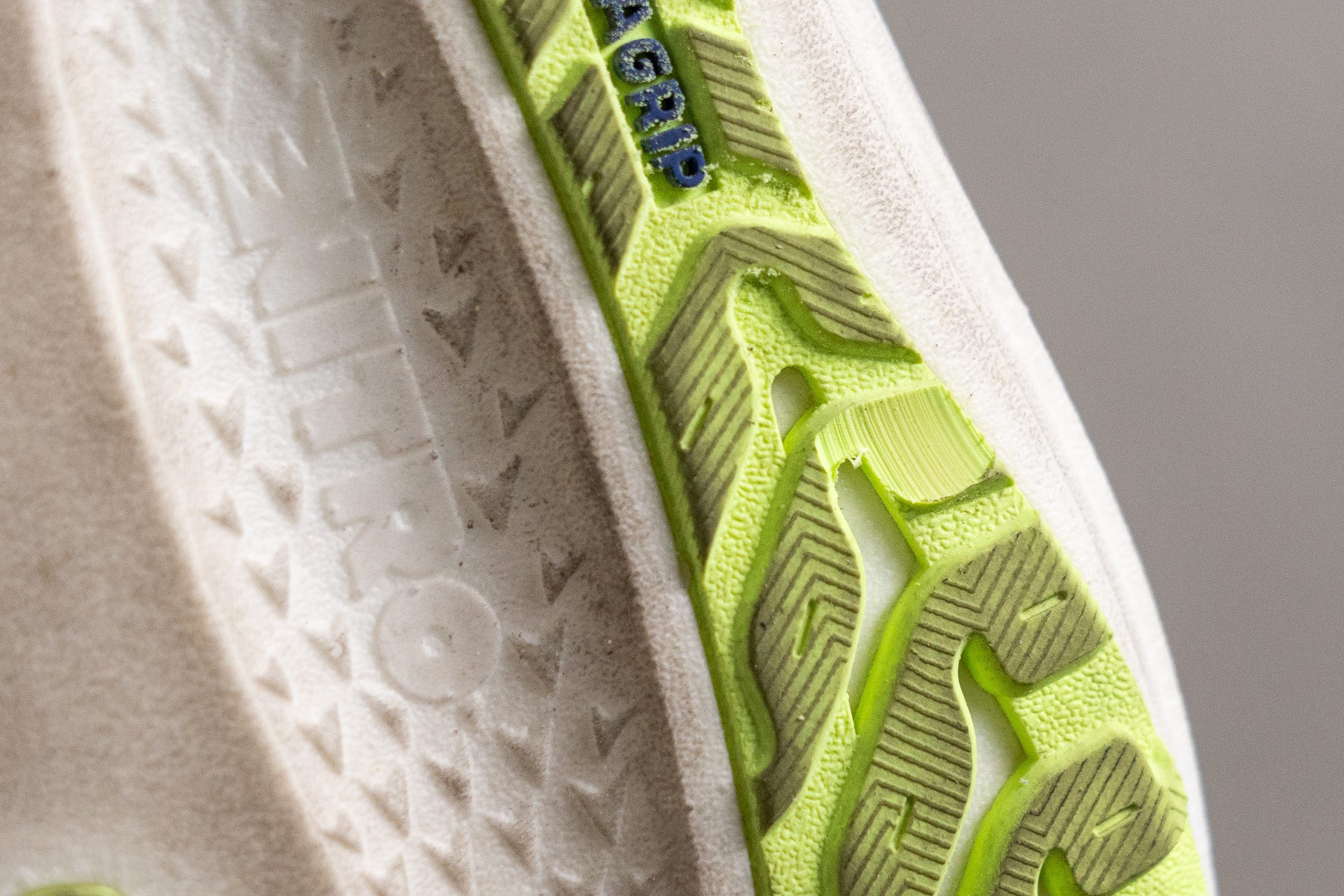
| Puma MagMax Nitro | 1.4 mm |
| Average | 1.1 mm |
Outsole thickness
Why do we think so? Because Puma, knowing the low wear-resistance of its PumaGrip compound, used 3.5 mm of thickness to ensure durability and extend the shoe's shelf life.
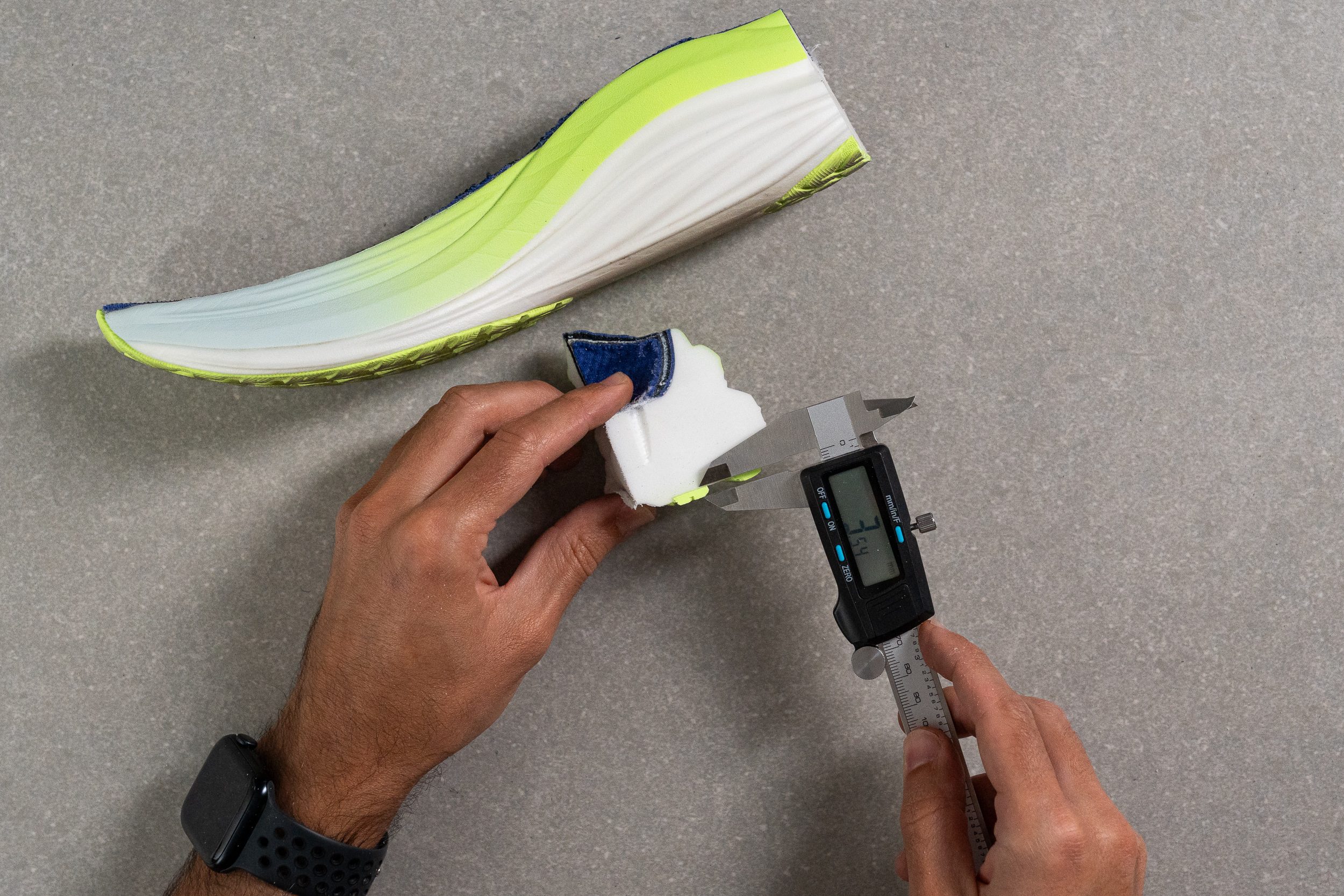
| Puma MagMax Nitro | 3.5 mm |
| Average | 3.2 mm |
Misc
Insole thickness
We used our digital calipers to measure the insole thickness, and it turned out to be just 3.3 mm—much thinner than we expected for this shoe. Maybe we were biased, assuming the MagMax Nitro had everything in XXL size!
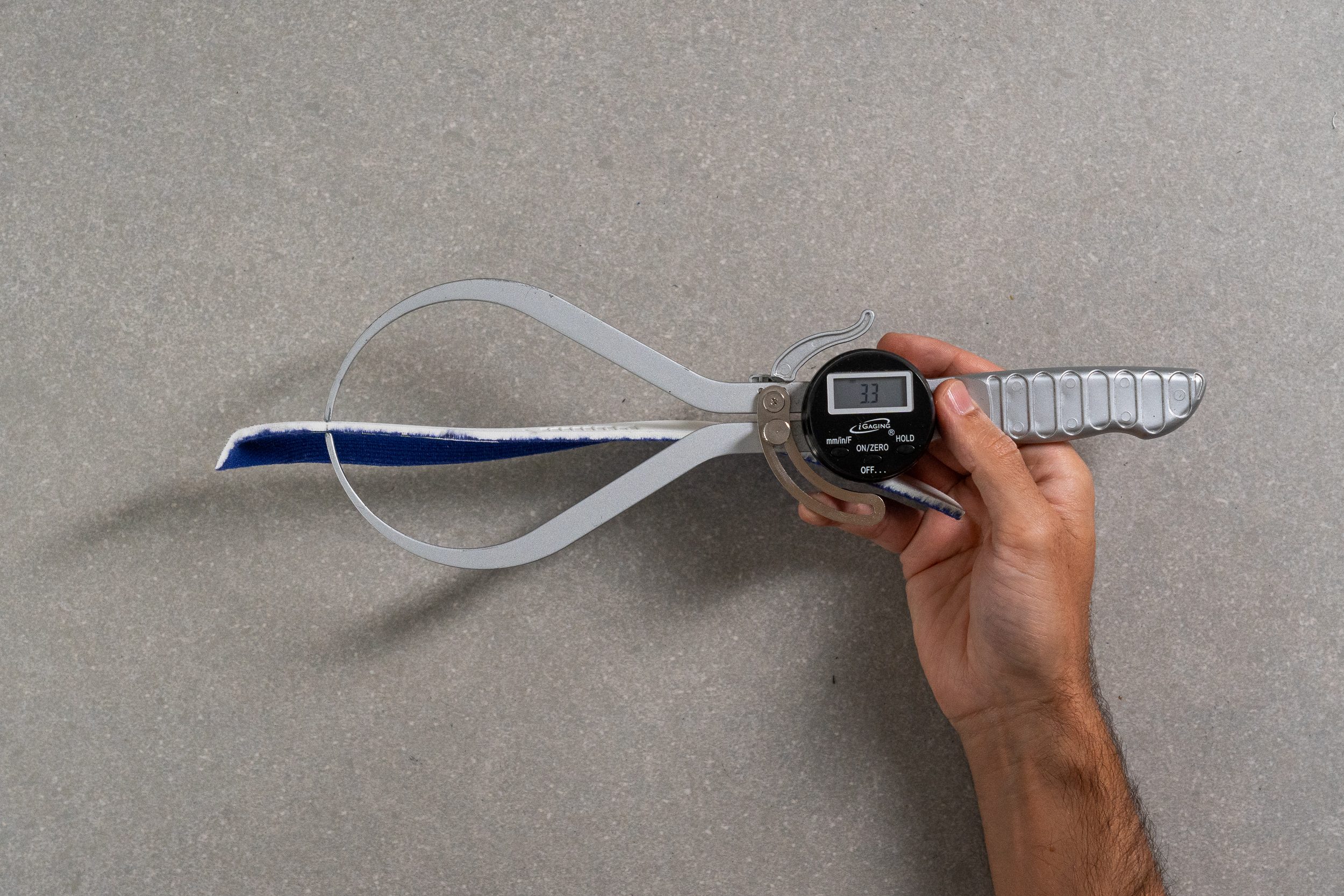
| Puma MagMax Nitro | 3.3 mm |
| Average | 4.5 mm |
Removable insole
The stock insole can be replaced with a standard one, but you’ll lose the cozy, bucket-like footbed that enhances heel lockdown in the MagMax.
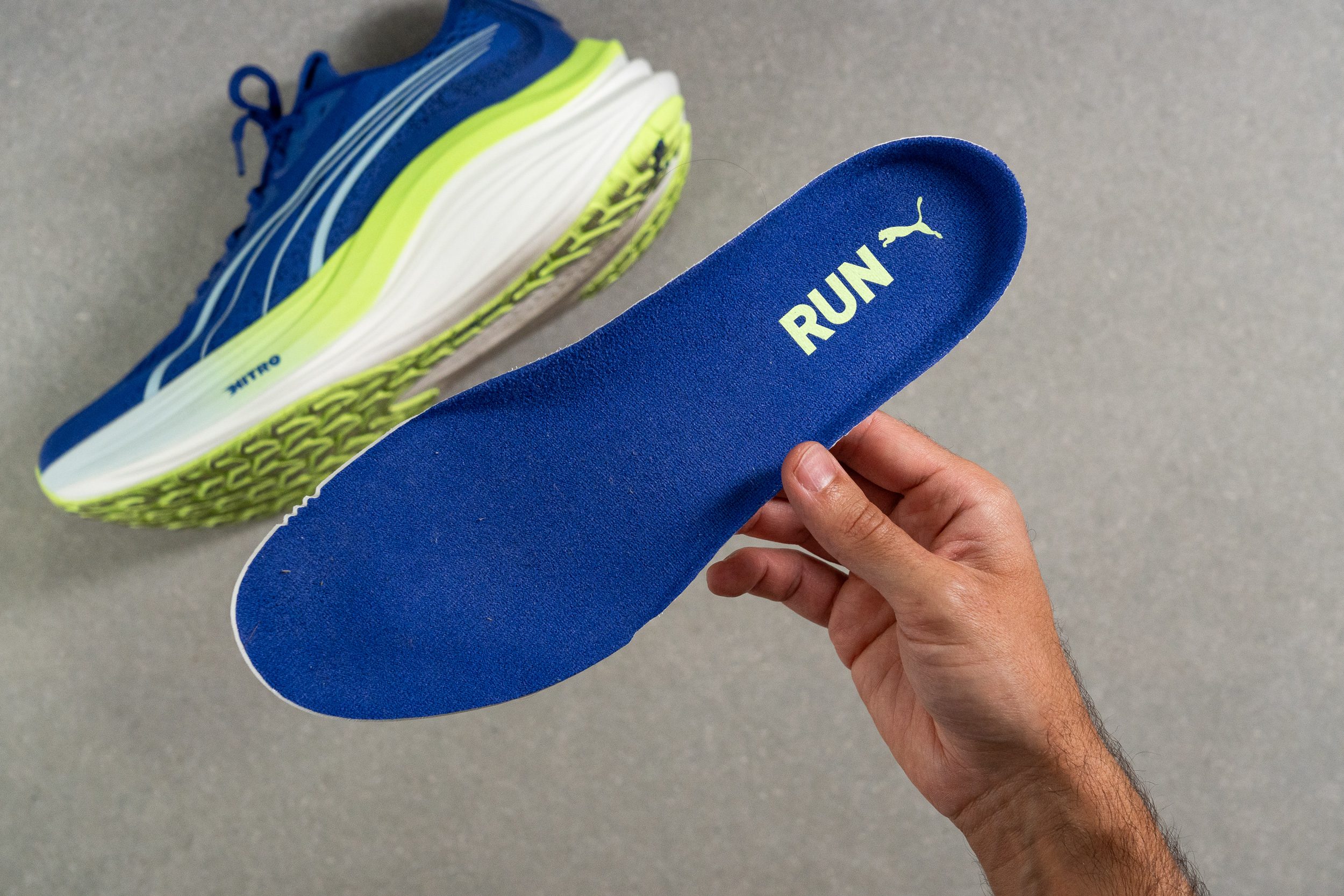
| Puma MagMax Nitro | Yes |
Midsole softness in cold (%)
After placing the MagMax Nitro in the freezer for 20 minutes, we tested it again with our durometer.
In our view, the outcome was underwhelming—28.3 HA, reflecting a substantial 54.8% uptick.
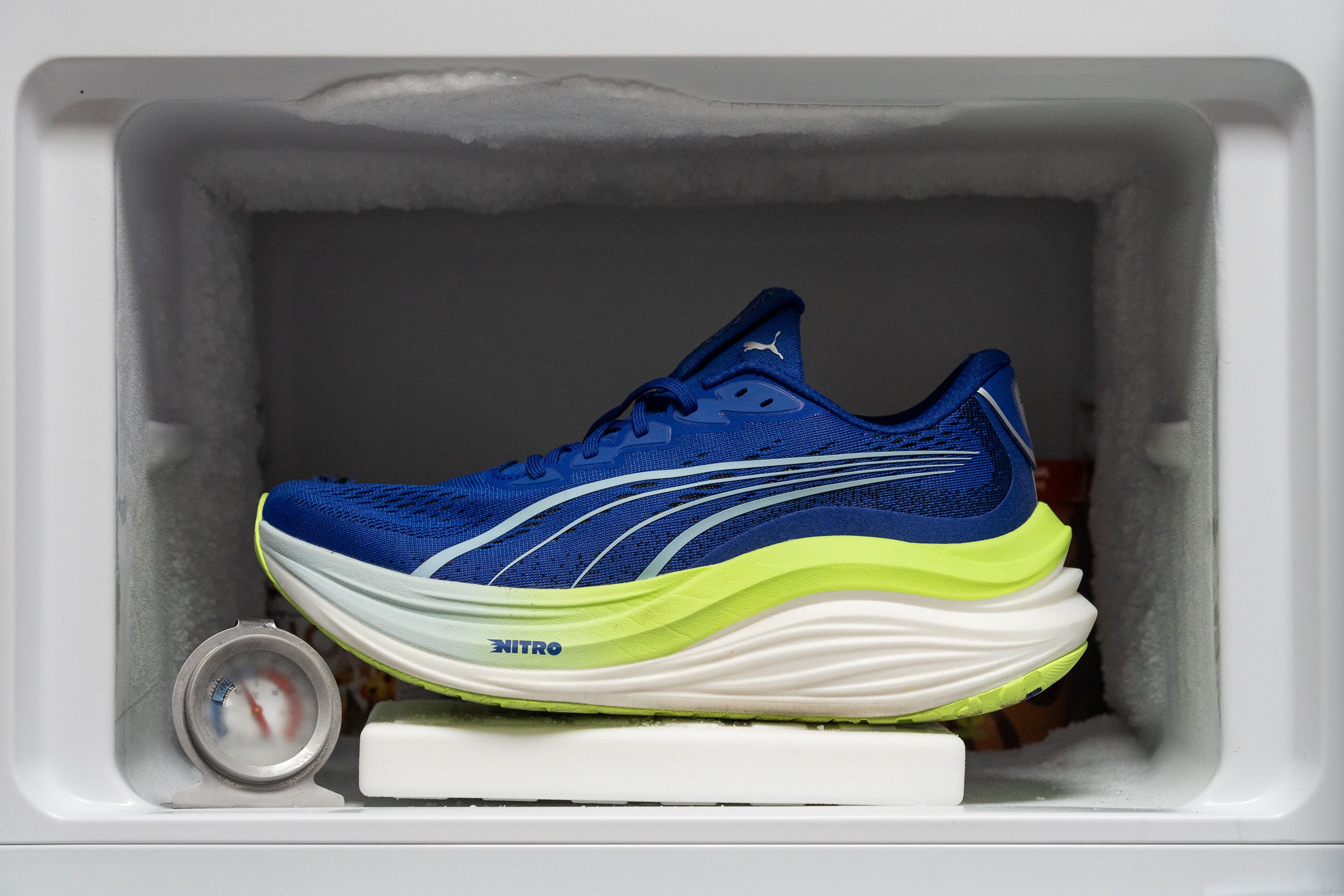
| Puma MagMax Nitro | 55% |
| Average | 24% |
Reflective elements
We were thrilled to discover reflective elements in the MagMax—something Puma has been skipping in some of their top-tier trainers recently. In our view, this is a smart safety feature, and we’re all for it!
| Puma MagMax Nitro | Yes |
Tongue padding
One of the standout elements of the MagMax Nitro is its tongue.

Unlike most running shoes that match the tongue material with the upper, Puma impressed us by opting for a stretchy design paired with a massive pull tab that instantly reminded us of the ASICS Nimbus 26.
At 7.1 mm thick with two slabs of foam, it strikes a perfect balance between plush comfort and minimal weight—a smart choice that enhances the overall feel without adding bulk.
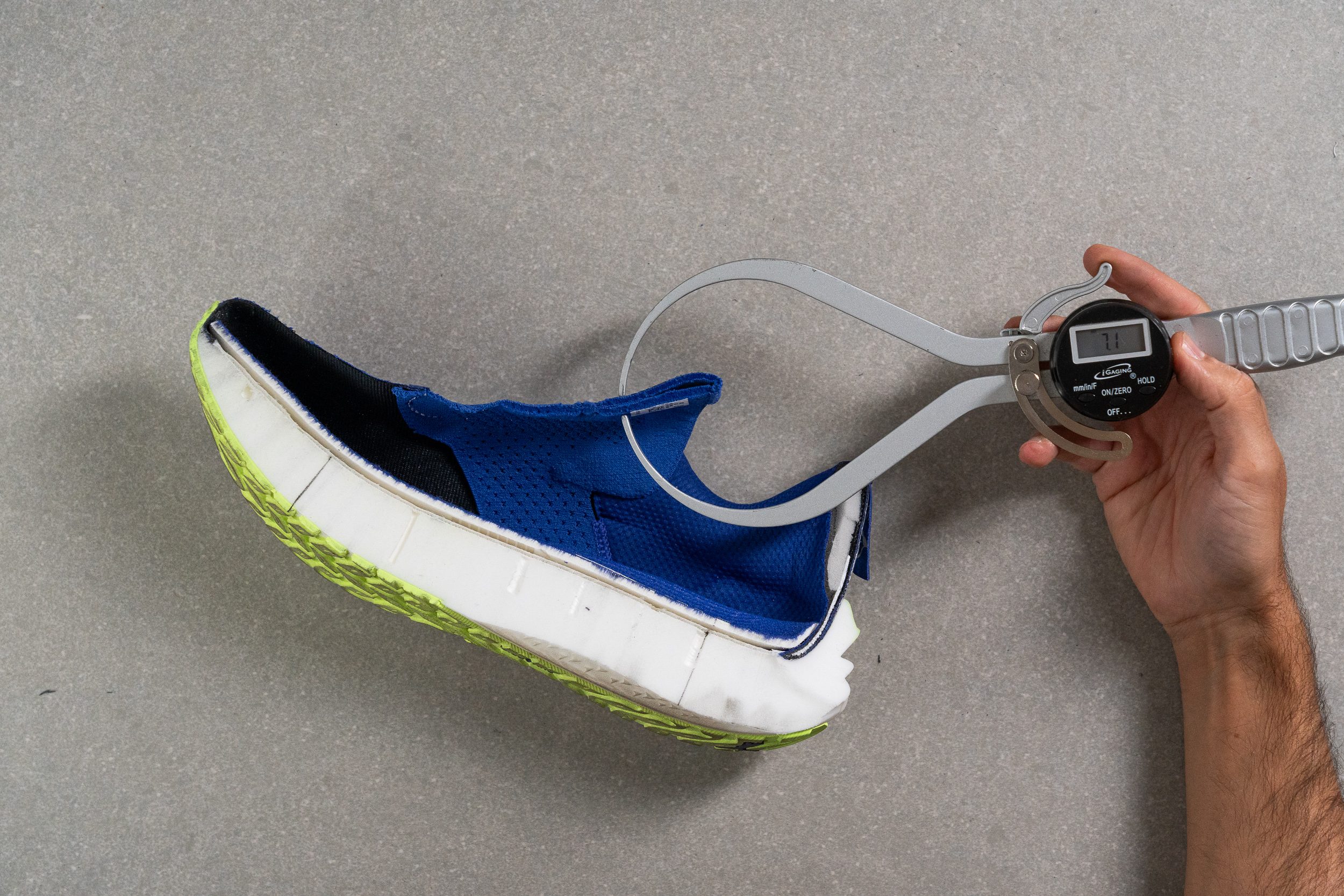
| Puma MagMax Nitro | 7.1 mm |
| Average | 5.8 mm |
Tongue: gusset type
Puma chose a semi-gusseted tongue for the MagMax Nitro, and we believe it’s the right call. A non-gusseted tongue would feel subpar in a £180 shoe, while a fully gusseted version could have been overwhelming and airflow-restrictive.

| Puma MagMax Nitro | Both sides (semi) |
Price
Maximalist running shoes often come with maximalist price tags, and the MagMax is no exception. While it’s not the most expensive supertrainer we’ve seen, it’s certainly not a budget-friendly option either.

Is it worth the investment? Well, we believe it is. In our experience, the combination of a luxurious upper, endless cushioning, and a world-class outsole makes the price justified.
| Puma MagMax Nitro | $180 |
Heel tab
The MagMax opts for a flap-style pull tab against the heel similar to Adizero shoes like the Adidas Adizero SL2. And they definitely took a prankish approach with this one!

| Puma MagMax Nitro | Pull tab |





























































